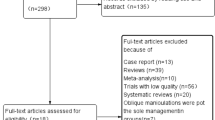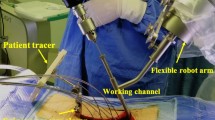Abstract
Objective
The Isocentric C-arm 3D navigation has been widely used in superior cervical surgeries in recent years. Several clinical researches reported that navigation system was an effective support device for treatment of atlantoaxial instability. But there were few studies about the advantages of navigation system compared to conventional C-arm fluoroscopy in C1–C2 transarticular screw fixation for atlantoaxial instability. The aim of the study was to evaluate the precision of computer-assisted C1–C2 transarticular screw fixation (Magerl’s technique) for atlantoaxial instability and compare the clinical results with conventional C-arm fluoroscopy.
Methods
Forty-two patients diagnosed as atlantoaxial instability who underwent C1–C2 transarticular screw fixation under two different fluoroscopy methods were studied. The Iso-C 3D navigation group included 18 patients and the other 24 patients were in the conventional C-arm group. The clinical and radiographic results were recorded and compared between the two groups. Patients were followed up with clinical examination and radiographs at a mean of 18.4 months.
Results
There were no significant differences between two groups in the mean age, gender, and causes of atlantoaxial instability. The mean blood loss in the navigation group was 236.1 ± 28.5 mL versus 308.3 ± 21.2 mL in the conventional C-arm group. The radiation time was significantly reduced using 3D navigation (48.8 ± 1.05 s versus 60.3 ± 2.23 s). Overall, 97.2 % (35/36) of 3D navigated screws and 91.7 % (44/48) of fluoroscopy screws were placed into the C1–C2 transarticular passages. Thirty-nine of forty patients showed evidence of solid fusion after 12 months on cervical plain radiographies or CT scans.
Conclusions
On comparing the two imaging techniques, it was found that using Iso-C 3D navigation can improve accuracy of the C1–C2 transarticular screws, decrease intra-operative fluoroscopic time and blood loss, and not prolong the operative time. This study demonstrates that Iso-C 3D navigation is a safe and effective means of guiding C1–C2 transarticular screw fixation for atlantoaxial instability.







Similar content being viewed by others
References
Briem D, Linhart W, Lehmann W, Begemann PG, Adam G, Schumacher U et al (2006) Computer-assisted screw insertion into the first sacral vertebra using a three-dimensional image intensifier: results of a controlled experimental investigation. Eur Spine J 15:757–763
Citak M, Kendoff D, Kfuri M Jr, Pearle A, Krettek C, Hufner T (2007) Accuracy analysis of Iso-C3D versus fluoroscopy-based navigated retrograde drilling of osteochondral lesions: a pilot study. J Bone Joint Surg Br 89:323–326
Dickman CA, Sonntag VK (1998) Posterior C1–C2 transarticular screw fixation for atlantoaxial arthrodesis. Neurosurgery 43:275–280 (discussion 280–271)
Gebhard FT, Kraus MD, Schneider E, Liener UC, Kinzl L, Arand M (2006) Does computer-assisted spine surgery reduce intraoperative radiation doses? Spine 31:2024–2027 (discussion 2028)
Gluf WM, Schmidt MH, Apfelbaum RI (2005) Atlantoaxial transarticular screw fixation: a review of surgical indications, fusion rate, complications, and lessons learned in 191 adult patients. J Neurosurg Spine 2:155–163
Haid RW Jr, Subach BR, McLaughlin MR, Rodts GE Jr, Wahlig JB Jr (2001) C1–C2 transarticular screw fixation for atlantoaxial instability: a 6 year experience. Neurosurgery 49:65–68 (discussion 69–70)
Kazan S, Yildirim F, Sindel M, Tuncer R (2000) Anatomical evaluation of the groove for the vertebral artery in the axis vertebrae for atlanto-axial transarticular screw fixation technique. Clin Anat 13:237–243
Madawi AA, Casey AT, Solanki GA, Tuite G, Veres R, Crockard HA (1997) Radiological and anatomical evaluation of the atlantoaxial transarticular screw fixation technique. J Neurosurg 86:961–968
Magerl F, Seemann P-S (1987) Stable posterior fusion of the atlas and axis by transarticular screw fixation. In: Kehr P, Weidner A (eds) Cervical Spine I. Springer, Wien, pp 322–327
Martirosyan NL, Kalb S, Cavalcanti DD, Lochhead RA, Uschold TD, Loh A et al (2013) Comparative analysis of isocentric 3-dimensional C-arm fluoroscopy and biplanar fluoroscopy for anterior screw fixation in odontoid fractures. J Spinal Disord Tech 26:189–193
Rajasekaran S, Tubaki VR, Shetty AP (2012) Results of direct repair of type 2 hangman fracture using Iso-C3D navigation: 20 cases. J Spinal Disord Tech 25:E134–E139
Sim HB, Lee JW, Park JT, Mindea SA, Lim J, Park J (2011) Biomechanical evaluations of various c1–c2 posterior fixation techniques. Spine 36:E401–E407
Smith HE, Welsch MD, Sasso RC, Vaccaro AR (2008) Comparison of radiation exposure in lumbar pedicle screw placement with fluoroscopy vs computer-assisted image guidance with intraoperative three-dimensional imaging. J Spinal Cord Med 31:532–537
Suchomel P, Stulik J, Klezl Z, Chrobok J, Lukas R, Krbec M et al (2004) Transarticular fixation of C1-C2: a multicenter retrospective study. Acta Chir Orthop Traumatol Cech 71:6–12
Summers LE, Kouri JG, Yang M, Patrick Jacob R (2008) Odontoid screw placement using Isocentric 3-dimensional C-arm fluoroscopy. J Spinal Disord Tech 21:45–48
Uehara M, Takahashi J, Hirabayashi H, Hashidate H, Ogihara N, Mukaiyama K et al (2012) Computer-assisted C1–C2 transarticular screw fixation “magerl technique” for atlantoaxial instability. Asian Spine J 6:168–177
Yang YL, Fu BS, Li RW, Smith PN, Mu WD, Li LX et al (2011) Anterior single screw fixation of odontoid fracture with intraoperative Iso-C 3-dimensional imaging. Eur Spine J 20:1899–1907
Wright NM, Lauryssen C (1998) Vertebral artery injury in C1–2 transarticular screw fixation: results of a survey of the AANS/CNS section on disorders of the spine and peripheral nerves. American Association of Neurological Surgeons/Congress of Neurological Surgeons. J Neurosurg 88:634–640
Weng C, Tian W, Li ZY, Liu B, Li Q, Wang YQ et al (2012) Surgical management of symptomatic os odontoideum with posterior screw fixation performed using the magerl and harms techniques with intraoperative 3-dimensional fluoroscopy-based navigation. Spine 37:1839–1846
Yang YL, Zhou DS, He JL (2013) Comparison of isocentric C-arm 3-dimensional navigation and conventional fluoroscopy for C1 lateral mass and C2 pedicle screw placement for atlantoaxial instability. J Spinal Disord Tech 26:127–134
Acknowledgments
This work was supported by the Natural Science Foundation of Shandong Province under Grant BS2014YY024.
Conflict of interest
The authors declare that they have no conflict of interest.
Author information
Authors and Affiliations
Corresponding authors
Additional information
Y. Yang and F. Wang contributed equally to the study.
Rights and permissions
About this article
Cite this article
Yang, Y., Wang, F., Han, S. et al. Isocentric C-arm three-dimensional navigation versus conventional C-arm assisted C1–C2 transarticular screw fixation for atlantoaxial instability. Arch Orthop Trauma Surg 135, 1083–1092 (2015). https://doi.org/10.1007/s00402-015-2249-z
Received:
Published:
Issue Date:
DOI: https://doi.org/10.1007/s00402-015-2249-z




